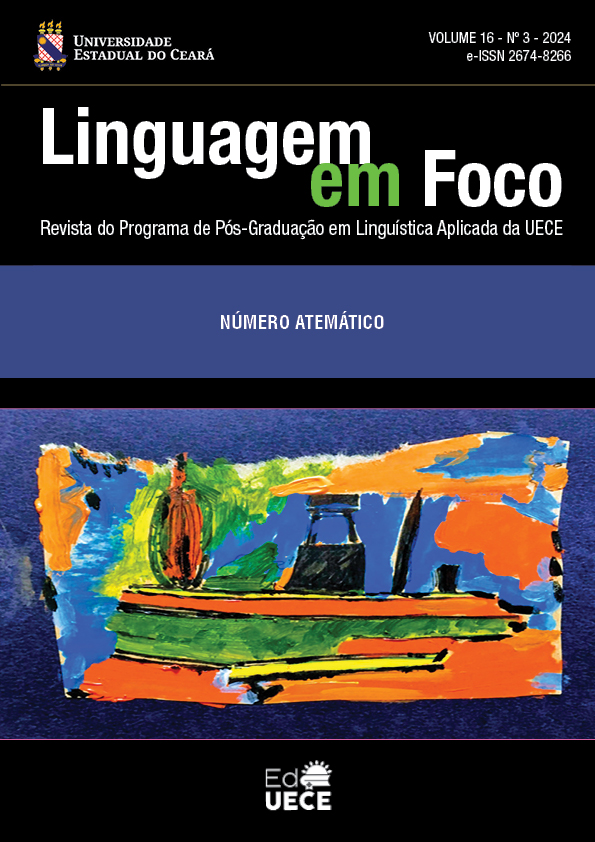Investigating interlanguage in present perfect acquisition through translation
DOI:
https://doi.org/10.46230/lef.v16i3.12808Palavras-chave:
second language acquisition, proficiency, interlanguage, present perfect, translationResumo
The paper uses the blind translation into English of a youth reader originally written in Portuguese by two Brazilian college students with different proficiency levels – one upper-intermediate, who has never lived in an English-speaking country though visits her mother in the US often, and the other one advanced, who lived in the US with his family from the age 4 to the age 14 – to verify if Selinker’s (1972; 2013, elsewhere) interlanguage hypothesis holds as far as the use of the present perfect goes. The two outcomes are contrasted with the translation of the reader by a Portuguese/English bilingual native speaker. The methodology for the case-study at hand is a quantitative-qualitative analysis of the data we gathered: Taking into consideration not only the number of tokens each of the three translations includes but also the typological nuances the verb tense encompasses in the three outputs, the investigation yields as a result an inference that can be drawn from our here observed continuum upper-intermediate student > advanced student > bilingual speaker for the use of the present perfect, as far as how the verb tense interacts with Selinker`s interlanguage hypothesis, namely, that subsequent surveys shall yield similar conclusions. After all, the 3 participants involved are correspondingly high-performance informants, which renders the current case study outstandingly representative. We deployed Comrie (1976) and McCawley (1971) as benchmark for the shades of meaning the present perfect in English may convey.
Downloads
Referências
BINNICK, R. I. (ed.) The handbook of tense and aspect. Oxford/New York: Oxford University Press, 2012.
BOOGART, R.; JANSSEN, T. Tense and aspect. In: GEERAERTS, D.; CUYCKENS, H. (eds.) The Oxford handbook of cognitive linguistics. Oxford/New York: Oxford University Press, 2007. p. 803-828.
CELCE-MURCIA, M.; LARSEN-FREEMAN, D. The grammar book: an esl/efl teacher’s course. 2nd edition. Newbury: Heinle & Heinle, 1999.
CHEN, J. J. The development of an interlanguage. Tesol Journal, v. 3, n. 1, p. 48, 2016.
COMRIE, B. Aspect. Cambridge, UK: Cambridge University Press, 1976.
COMRIE, B. Tense. Cambridge, UK: Cambridge University Press, 1985.
DOWTY, D. Word meaning and Montague grammar. Dordrecht: Reidel, 1979.
DUBINER, D. Second language learning and teaching. From theory to a practical checklist. Tesol Journal, v. 10, n. 2, p. e00398, Wiley Online Library, 2019. Available in: https://onlinelibrary.wiley.com/doi/10.1002/tesj.398?msockid=3b7669d74d9468b609ce7da94c806934. Access on: 04 Dec. 2024.
FONSECA, M. C. M. Por que é tão difícil ensinar o Present Perfect na escola. In: BRUNO, F. (org.) Ensino-aprendizagem de línguas estrangeiras: reflexão e prática. São Carlos: Claraluz, 2005. p. 103-114.
FONSECA, M. C. M. Descrição da oposição Present Perfect vs Simple Past. Cadernos do IL, Porto Alegre, n. 44, p. 259-278, 2012.
HAN, Z.; TARONE, E. (eds.) Interlanguage forty years later. Amsterdam: John Benjamins, 2014.
HAWKINS, R. Measurements of second language proficiency. In: JOHNSON, K.; JOHNSON, H. (eds.) Encyclopedic dictionary of applied linguistics. Oxford, UK: Blackwell, 1999, p. 209-211.
HURFORD, J. R. Grammar: a student’s guide. Cambridge: Cambridge University Press, 1994.
LANGACKER, R. Foundations of cognitive grammar: descriptive application. Stanford: Stanford University Press, 1991.
MATTHEWS, P. H. Oxford concise dictionary of linguistics. Oxford, UK: Oxford University Press, 1997.
MCCAWLEY, J. D. Tense and time reference in English. In: FILLMORE, C. J.; LANGENDOEN, T. (eds.) Studies in linguistic semantics. Irvington, 1971. p. 96 -113.
MCCAWLEY, J. D. Notes on the English present perfect. Australian Journal of Linguistics v. 1, n. 1, p. 81-90, 1981.
MELLO, H.; DUTRA, D. The teaching of aspectual categories to Brazilian Portuguese speakers. Series B: applied and interdisciplinary papers. Essen: LAUD, Paper n. 300, p. 1-8, separate offprint, 2000.
MENDES, V. S. Mapeamento forma-função do tempo-aspecto referente ao Present Perfect em obra infanto-juvenil traduzida para o inglês a partir do original em português. Projeto de pesquisa apresentado em resposta ao edital Pibic PROPPG UFSB. Porto Seguro, unpublished manuscript, 2020.
MICHAELIS, L. A. Aspectual grammar and past-time reference. London/New York, Routledge, 1998.
MURPHY, R. English grammar in use. A self-study reference and practice book for intermediate students. Second edition. Cambridge, UK: Cambridge University Press, 1994.
OLIVEIRA, A. A. O estudo da interlíngua por meio de abordagens combinadas baseadas no uso. In: ZYNGIER, S.; VIANA, V.; JANDRE, J. (eds.) Linguagem, criatividade e ensino: abordagens empíricas e interdisciplinares. Rio de Janeiro: Publit, 2009. p. 79-108.
OLIVEIRA, A. A. Gramáticas distintas e seu papel no desenvolvimento da interlíngua. Gláuks v. 15, n. 1, p. 101-120, 2015. Available in: https://www.academia.edu/31453847/Distinct_Grammars_and_their_Role_in_Interlanguage_Development_Gram%C3%A1ticas_Distintas_e_seu_Papel_no_Desenvolvimento_da_Interl%C3%ADngua. Access on: 04 Dec. 2024.
PALMER, F. Mood and modality. Cambridge: Cambridge University Press, 1986.
PARROT, M. Grammar for English language teachers. 2nd ed. Cambridge: Cambridge University Press, 2010.
RABBANI, A. R. C. Vivian A Aranta. Porto Seguro: ARCR, 2018.
RABBANI, A. R. C. Vivian The Splant. Translated by Simeon Kohlman. Porto Seguro: ARCR, 2019.
RADFORD, A. English syntax: an introduction. Cambridge, UK: Cambridge University Press, 2004.
RICHARDS, J. C.; SCHMIDT, R. Longman dictionary of language teaching and applied linguistics. 4th ed. Harlow: Longman, 2013.
SELINKER, L. Interlanguage. International Review of Applied Linguistics, v.10, n.3, p. 209-231, 1972.
SELINKER, L. Rediscovering interlanguage. London/New York: Routledge, 1992.
SELINKER, L. Interlanguage. In: ROBINSON, P. J. (ed.) The Routledge encyclopedia of second language acquisition. London/New York: Routledge, 2013. p. 338-342.
SEVERINO, A. J. Metodologia do trabalho científico. 24ª edição revista e atualizada. São Paulo: Cortez, 2018.
SOAR, J.; SOAR, L. American headway, 3rd ed. Level 2. Oxford: Oxford University Press, 2018.
SWAN, M. Practical English usage. 3rd new fully revised edition. Oxford: Oxford University Press, 2005.
TRASK, R. L. A dictionary of grammatical terms in linguistics. London / New York: Routledge, 1993.
Downloads
Publicado
Como Citar
Edição
Seção
Licença
Copyright (c) 2025 Vicente Mendes

Este trabalho está licenciado sob uma licença Creative Commons Attribution 4.0 International License.
Os autores que publicam na Linguagem em Foco concordam com os seguintes termos:
- Os autores mantêm os direitos autorais e concedem à revista o direito de primeira publicação. Os artigos estão simultaneamente licenciados sob a Creative Commons Attribution License que permite a partilha do trabalho com reconhecimento da sua autoria e da publicação inicial nesta revista.
- Os conceitos emitidos em artigos assinados são de absoluta e exclusiva responsabilidade de seus autores. Para tanto, solicitamos uma Declaração de Direito Autoral, que deve ser submetido junto ao manuscrito como Documento Suplementar.
- Os autores têm autorização para disponibilizar a versão do texto publicada na Linguagem em Foco em repositórios institucionais ou outras plataformas de distribuição de trabalhos acadêmicos (ex. ResearchGate, Academia.edu).





























